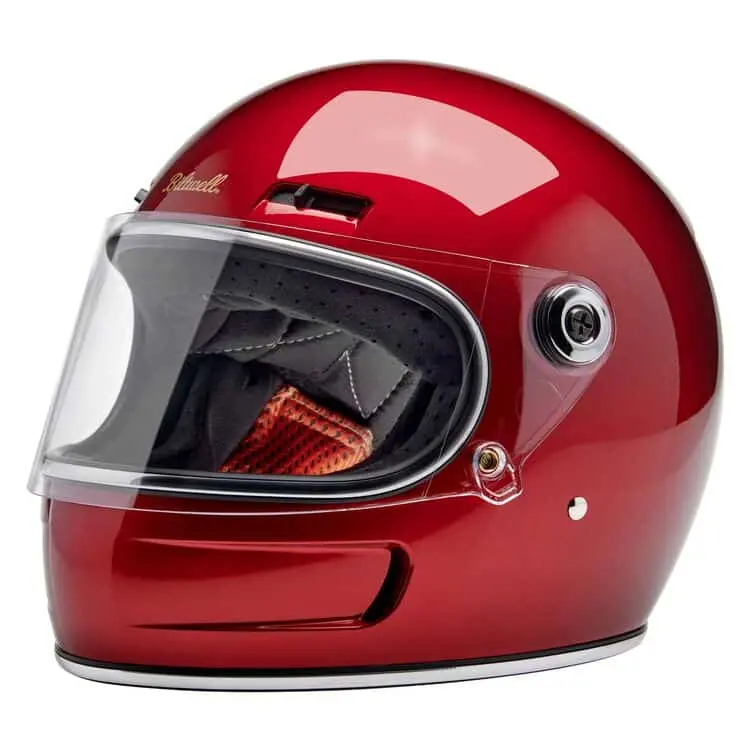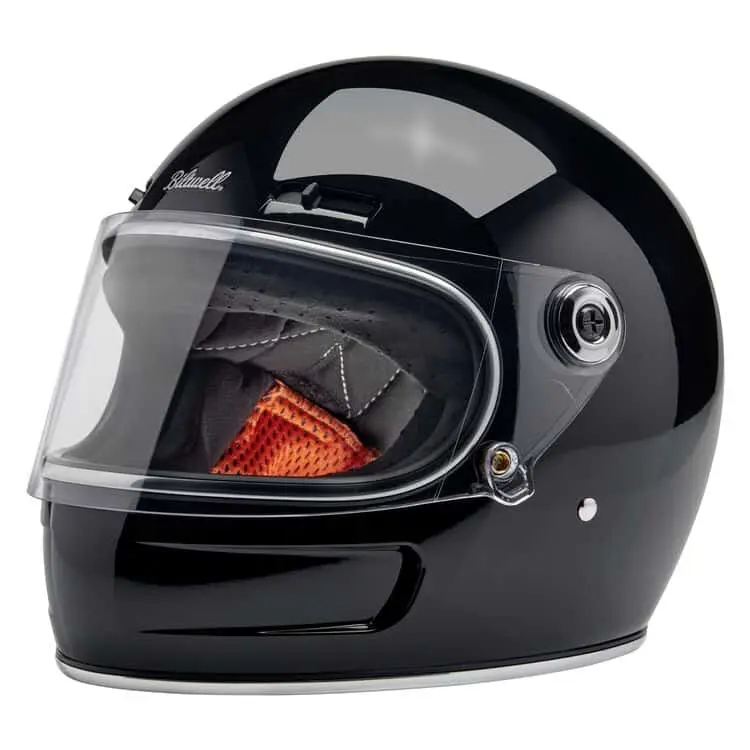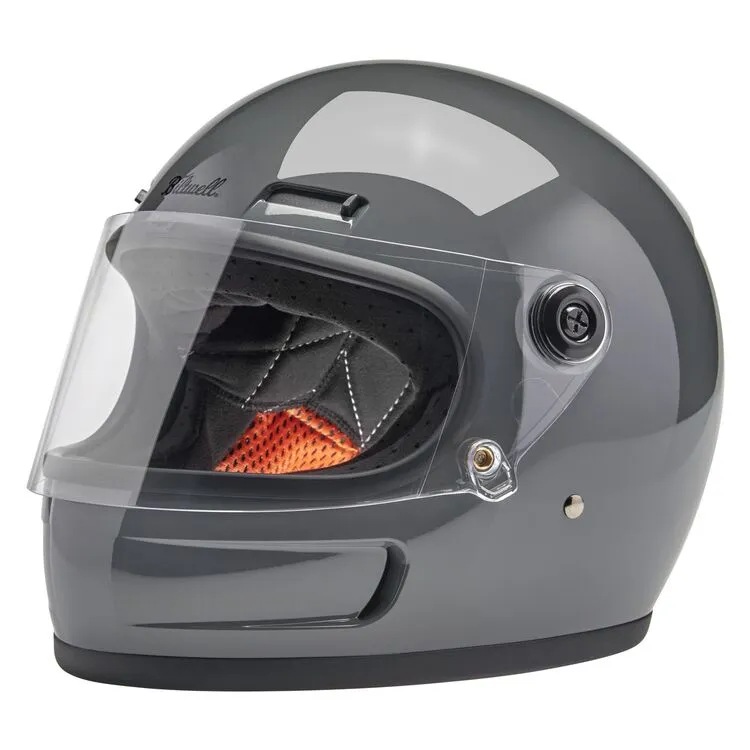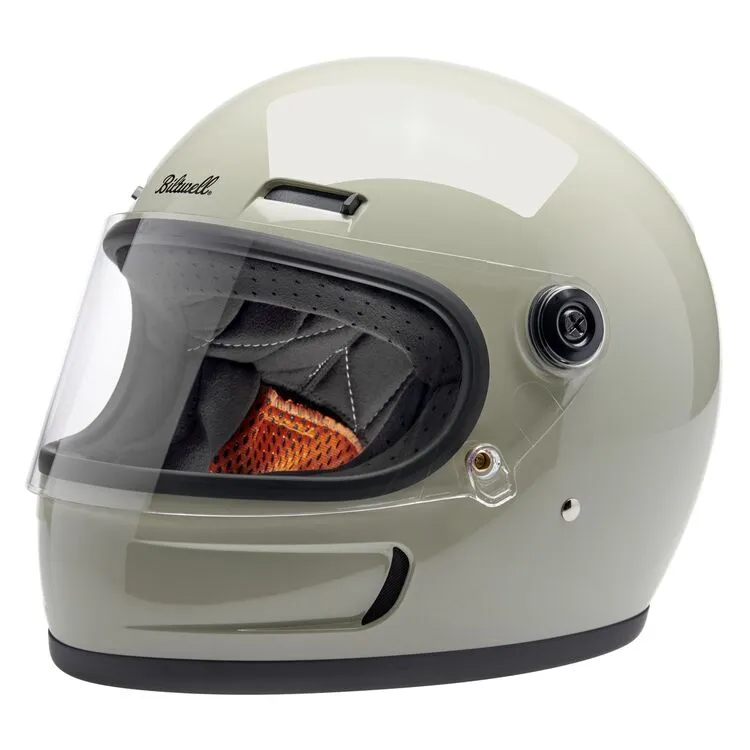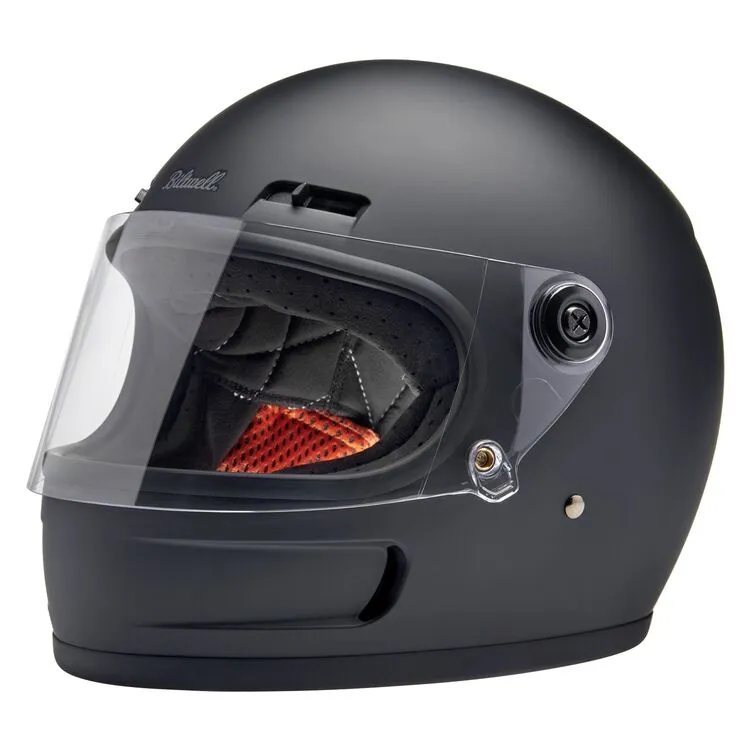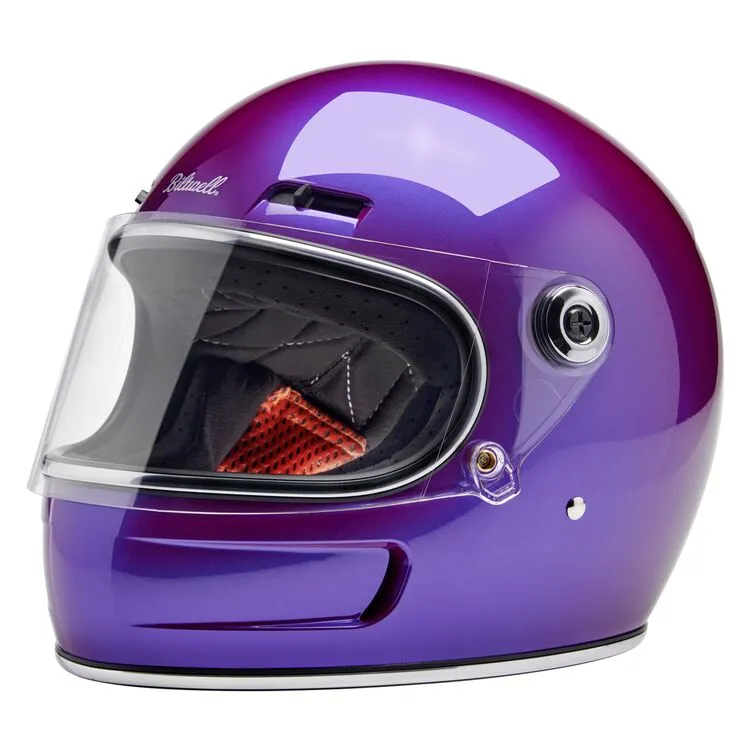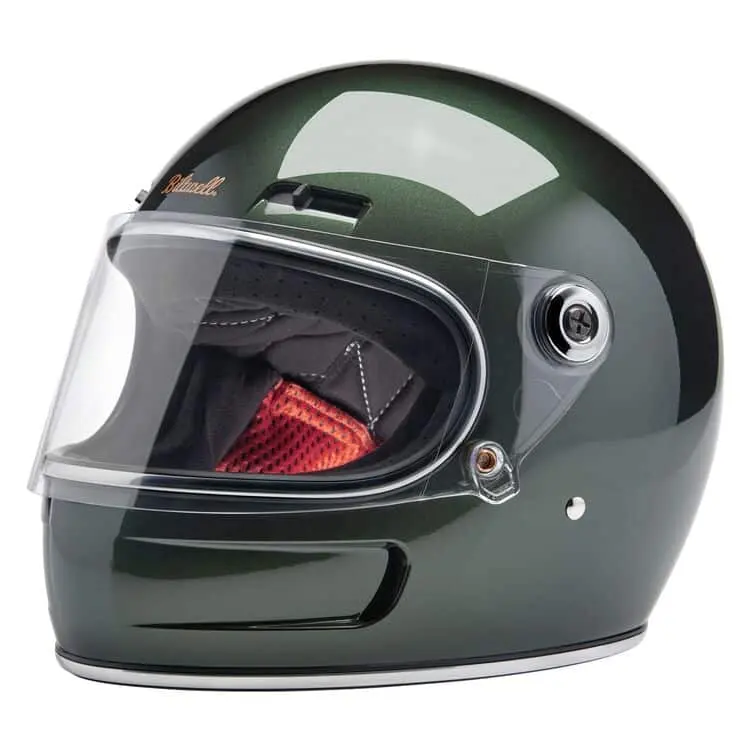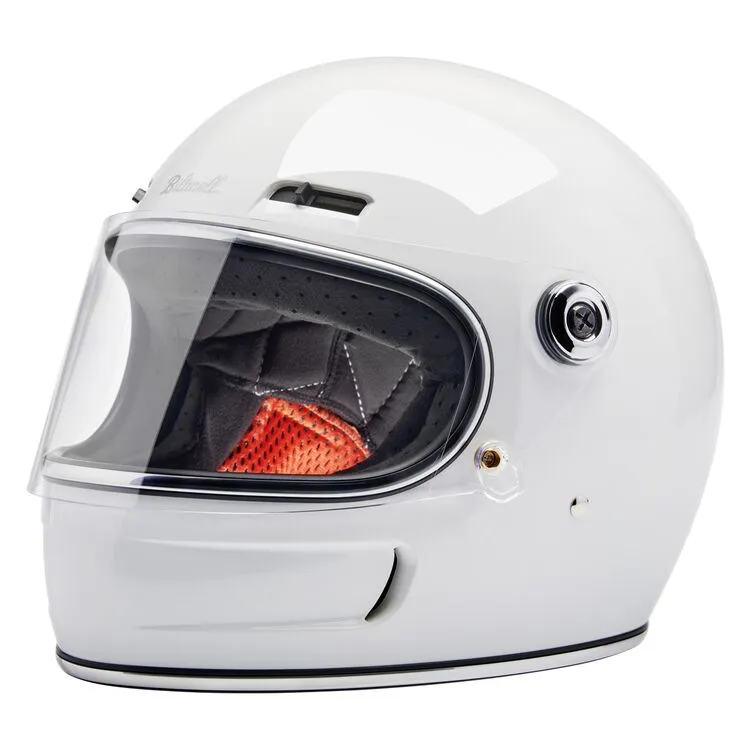This Biltwell Gringo SV review exposes the unvarnished reality of owning this retro full-face helmet through six months of intensive real-world testing.
I’ve subjected this lid to everything from scorching summer commutes to rain-soaked weekend rides, documenting every strength and weakness that emerged during extended use.
But after our extensive testing, does this comprehensive Biltwell Gringo SV review validate the hype surrounding this controversial helmet, or will it confirm your worst suspicions about prioritizing aesthetics over engineering excellence?
Biltwell Gringo SV

Key Takeaways
- Runs extremely small
- Requires mandatory earplugs usage
- Delivers fantastic cooling performance
- Accommodate large Bluetooth devices
Our Biltwell Gringo SV Results
I’ve put together an in-depth review of the Biltwell Gringo SV, covering everything from its ABS shell construction to real-world performance across six months of testing. But I get it – sometimes you just want the highlights.
Click the tabs below for a quick summary of what I like and dislike about this retro helmet and any potential drawbacks I’ve discovered. I’ve also added a video review where this lid is put through its paces during highway rides, city commutes, and everything in between.
It’s perfect if you’re in a hurry or just want to get a feel for whether this ECE 22.06 certified brain bucket is worth your hard-earned cash, especially considering its well-documented sizing and noise challenges.
My Thoughts About the Biltwell Gringo SV Helmet
Biltwell Gringo SV delivers exactly what it promises – a legitimate retro helmet that looks fantastic while meeting modern safety standards, though it demands compromises that define the entire ownership experience. After six months of testing this $299.99 helmet across diverse riding conditions, I’ve discovered it succeeds brilliantly within its intended niche while falling short in areas that matter for serious riding.
Biltwell Gringo SV Delivers Outstanding Value
Biltwell Gringo SV combines ECE R22.06 certification with genuinely striking aesthetics at a price point that undercuts premium competitors by hundreds of dollars. The helmet’s ABS shell construction provides legitimate impact protection while maintaining the classic simple silhouette that makes café racer enthusiasts choose Biltwell over more functional alternatives.
Ventilation performance genuinely impressed me during summer rides, with the five integrated vents creating copious airflow that kept my head noticeably cooler than non-vented alternatives. The adjustable brow vents with three different settings allow precise airflow control, while the permanently open chin bar vents ensure constant cooling to the lower face area.
Color variety represents one of Biltwell’s strongest advantages, offering eight different colorways from conservative matte black to eye-catching metallic cherry red that photographs beautifully and maintains vibrancy. The wide variety of eye-catching colors consistently receives praise from forum users who appreciate having aesthetic options at this price point.
Speaker pocket design accommodates larger JBL speakers from Cardo systems without creating pressure points or fit issues. I found plenty of room for my Bluetooth setup with clean wire routing that doesn’t interfere with the comfort liner installation.
Potential Drawbacks You Should Consider
Biltwell Gringo SV paint fragility creates cosmetic concerns, with one customer reporting chipping easily from contact with jacket zippers. The exterior finish requires careful handling to prevent damage that isn’t covered under Biltwell’s warranty exclusions for surface finish degradation.
Visor scratching occurs through normal operation, where the shield rubs against the metal trim during opening and closing, creating visible wear marks despite anti-scratch treatment claims. The awkward visor locking system compounds usability issues, requiring specific manipulation that makes users worry about potential breakage.
Double-D fastener positioning creates daily annoyance, with the button tucked too high on the strap and right against the lid making it a genuine nuisance to operate. This design flaw affects routine helmet use and becomes particularly frustrating when wearing gloves.
Interior pilling affects the fabric after several rides, while the copious ventilation makes the helmet decidedly not suitable for winter riding despite excellent warm-weather performance. The permanently open chin bar vents can’t be closed, limiting the helmet’s seasonal versatility.
Communication system performance suffers from the helmet’s high noise levels, requiring speaker volume louder than normal while still making it difficult to make out certain communications clearly. Even premium Bluetooth systems struggle against the helmet’s acoustic environment.
I’d recommend this helmet for riders who prioritize vintage aesthetics and competitive pricing over refined comfort and quiet operation. It’s perfect for casual rides to the café strip and urban commuting where style matters as much as protection, but serious touring riders should consider quieter alternatives.
Prices change as special offers are available from RevZilla.com, so check out the best prices before buying elsewhere. RevZilla won’t be beaten on price with their price match guarantee. If the item doesn’t fit, or you’re just not happy with it, you can return any new, unused, and unaltered item within 90 days of delivery.
Specifications:
- Injection-molded ABS outer shell is lightweight and highly resistant to impacts
- Front, side, and rear vent ports to improve interior airflow, moisture dissipation, and cooling
- New Dual Density expanded polystyrene (EPS) internal safety shell absorbs and dissipates impact energy without compromising comfort
- 3 Shell sizes and 5 EPS liners for a perfect fit:
- Shell 1: XS-SM (EPS 1, EPS 2)
- Shell 2: MD-LG (EPS 3, EPS 4)
- Shell 3: XL-XXL (EPS 5)
- Adjustable vents above the eye port let you regulate internal airflow to cool and dry your head
- Molded urethane chin bar pad dissipates energy during front impact
- Chin strap features brushed fleece Lycra touchpoints for comfort
- D-ring retention system with red quick-release pull tab for speedy removal
- CE-certified, injection-molded polycarbonate face shield features anti-fog and anti-scratch treatments for durability and safety
- Rugged hinge hardware with robust detents allows you to ride with the shield open at slow speeds to increase cooling airflow
- Anodized aluminum washers and stainless-steel hinge screws can be swapped with different colors and finishes to personalize the look of your helmet (hinge hardware sets available separately)
- Removable/replaceable fleece comfort liner and fleece cheek pads
- Lycra and open-cell foam padding to absorb and evaporate perspiration
- New BioFoam head form panel and ventilated polyester padding maximize airflow around your head to ensure coolness and comfort
- Molded EPS ear pockets fit select aftermarket audio accessories
- US DOT FMVSS No. 218 compliant / ECE 22.06 certified
Biltwell Gringo SV Shell Materials
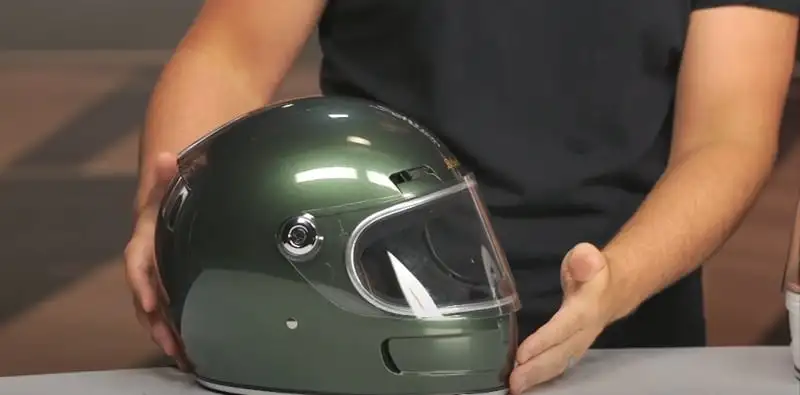
The Biltwell Gringo SV is built with an injection-molded ABS outer shell that delivers solid protection at an accessible price point.
The thermoplastic construction provides what the manufacturer describes as “lightweight yet robust” characteristics, though I’ve found the helmet is noticeably heavier than premium alternatives.
The ABS shell construction contributes directly to the Gringo SV’s competitive price. This thermoplastic material offers excellent impact resistance and can be molded into the helmet’s distinctive retro shape without compromising structural integrity.
When I examined the shell closely, I found that the injection-molding process creates consistent wall thickness throughout, which helps distribute impact forces effectively across the surface.
ABS plastic performs differently from premium materials in several key areas. While fiberglass helmets typically weigh 15-20% less than comparable ABS models, they also cost significantly more to manufacture.
Carbon fiber represents the premium end, offering superior strength-to-weight ratios but commanding prices often double or triple that of ABS construction.
The performance trade-offs become apparent during extended use. Polycarbonate and ABS materials absorb impact energy through controlled deformation, making them effective for lower-speed crashes but requiring thicker shells for adequate protection.
The consensus among budget-conscious riders centers on ABS providing adequate protection without the premium material costs that can push helmet prices beyond $600-800 USD.
Biltwell Gringo SV Head Shape and Fit
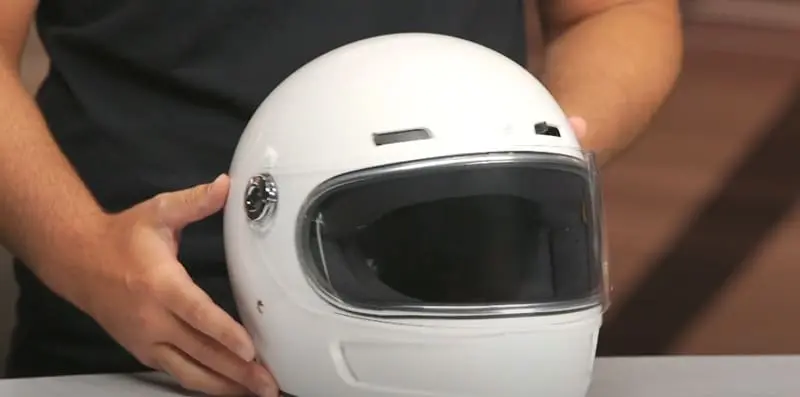
Biltwell Gringo SV is engineered with an intermediate oval fit that targets the majority of riders in the American market, but the reality proves more complex than Biltwell’s marketing suggests.
The helmet’s internal shape leans decidedly toward the rounder side of the spectrum, making it most compatible with standard or slightly rounded head shapes rather than the broader intermediate classification it claims.
Gringo SV delivers what I would describe as a slightly more universal fit compared to previous Biltwell models, though this improvement comes with significant caveats.
When I first slipped on the medium-size helmet – matching my 58cm head measurement – it created an “extremely tight squeeze” that required removing my earrings to avoid injury.
The round oval design becomes problematic for riders with overtly oval-shaped heads or narrower skull profiles.
If you have a “slightly narrower or longer face,” your chin could protrude at the bottom of the helmet opening, creating both comfort and safety concerns.
This geometric mismatch affects not just comfort but also the helmet’s protective capabilities, as improper fit compromises impact energy distribution across the shell.
Biltwell’s customer service representatives acknowledge the sizing challenges, though they claim the third iteration has become “more accurate”.
Despite this assertion, community feedback consistently points toward ordering one size larger than your typical helmet size.
Riders with long oval head shapes – those with greater front-to-back dimension relative to side-to-side width – will experience poor fit characteristics.
Intermediate oval classification suggests compatibility with the widest range of head shapes, yet practical experience reveals the Gringo SV favors rounder profiles exclusively.
Biltwell Gringo SV Aerodynamic Design Features
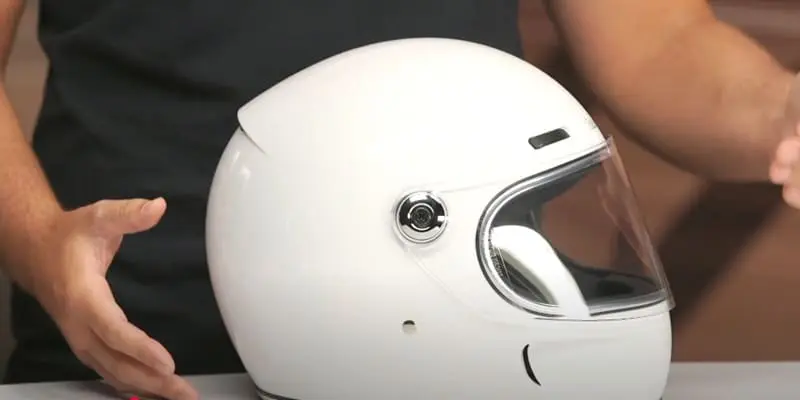
TheBiltwell Gringo SV is engineered with a aerodynamic subtle lip integrated cleanly into the shell’s rear section, functioning as a spoiler designed to channel airflow away from the helmet’s exhaust vent.
This aerodynamic element represents Biltwell’s attempt to modernize their classic Gringo silhouette without abandoning the retro aesthetic that defines the brand, though the execution reveals significant compromises in wind management performance.
The rear exhaust vent works in conjunction with the subtle lip to create what Biltwell describes as improved airflow management, but my experience riding at highway speeds reveals the limitations of this approach.
The spoiler design proves inadequate for meaningful drag reduction at speeds above 60 mph. This suggests the aerodynamic features prioritize ventilation over wind drag mitigation, creating a helmet that breathes well but fails to slice through air efficiently.
The helmet’s ABS construction weighs, and this mass, combined with its blunt frontal profile, creates substantial wind resistance that the rear spoiler cannot effectively counteract.
Modern sport touring helmets achieve superior aerodynamics through wind tunnel testing and computational fluid dynamics analysis – processes that Biltwell appears to have bypassed in favor of aesthetic considerations.
The poor visor seal compounds the aerodynamic challenges by allowing uncontrolled air leakage around the face shield perimeter.
This creates turbulent airflow patterns that generate the loud wind noise riders consistently report, while simultaneously reducing the effectiveness of the rear exhaust vent and spoiler combination.
While the subtle lip provides some airflow management benefits at city speeds, it lacks the aggressive angles and extended spoiler profiles found on performance-oriented helmets designed for high-speed stability.
The classic simple silhouette that makes this helmet visually appealing creates a blunt object that punches through the air rather than parting it efficiently.
Wind buffeting becomes particularly noticeable when riding behind windscreens or fairings, where the Gringo SV tends to catch and amplify turbulent air rather than deflecting it smoothly.
The ventilation ports at the front, side, and rear create additional air disturbance points that contribute to the helmet’s aerodynamic inefficiency.
Unlike dedicated sport helmets that feature aggressive aerodynamic appendages, the Gringo SV limits its spoiler design to what can be absorbed into the classic shell shape.
This constraint prevents the helmet from achieving meaningful wind drag improvements, leaving riders to accept elevated wind noise as the price for retro style.
Biltwell Gringo SV Sizing
Biltwell Gringo SV is notorious for its tricky sizing that consistently catches riders off guard, with the helmet fitting significantly smaller than Biltwell’s own size chart suggests.
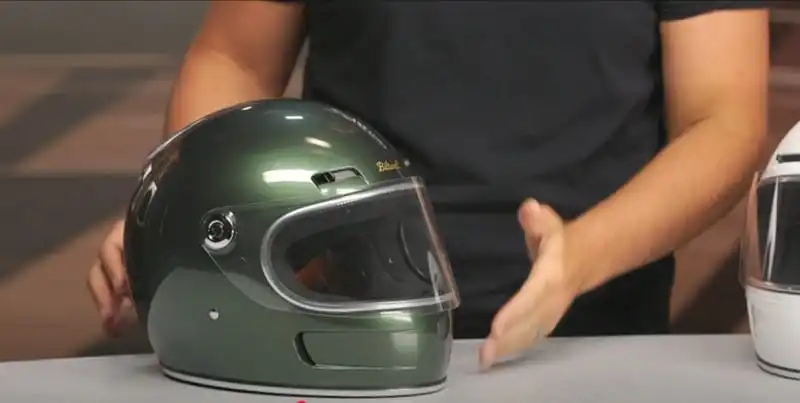
The manufacturer offers sizes ranging from XS through 2XL. Still, nearly every forum discussion and review emphasizes the same critical advice – size up by at least half to a full size from your normal helmet measurement.
The Gringo SV now utilizes three shell sizes instead of the previous two-shell construction, which Biltwell claims provides “more accurate and comfortable” fit, particularly for Medium and 2XL sizes.
This improvement helps avoid the “bobblehead” appearance that plagued earlier models, but it doesn’t solve the fundamental sizing problem that makes ordering the correct size feel like educated guesswork.
When I measured my head at 58cm (22.85 inches), Biltwell’s sizing chart indicated a Medium would fit perfectly.
The chin bar positioning creates another sizing complication that affects fit beyond just cheek pad thickness. I found the chin bar “seemed a little close,” suggesting the helmet’s internal geometry doesn’t scale proportionally across all size ranges.
This becomes particularly problematic for riders with longer faces who may experience restricted jaw movement.
Three shell sizes improve proportional scaling compared to the previous two-shell design, but the fundamental issue remains – Biltwell’s size chart doesn’t accurately reflect the helmet’s actual fit characteristics.
I wear a medium pretty much in all of my helmets across the board, but I had to size up to a large for a comfortable fit in the Gringo SV.
Biltwell Gringo SV Helmet Sizing Chart
Here’s the official Biltwell sizing chart for the Gringo SV helmet:
| Size | Head Measurement (inches) | Head Measurement (cm) | US Hat Size |
|---|---|---|---|
| XS | 20⅞ – 21⅜ | 53 – 54.25 | 6⅝ – 6⅞ |
| S | 21½ – 22 | 54.5 – 55.75 | 6⅞ – 7⅛ |
| M | 22⅛ – 22⅝ | 56 – 57.25 | 7⅛ – 7⅜ |
| L | 22¾ – 23¼ | 57.5 – 58.75 | 7⅜ – 7⅝ |
| XL | 23⅜ – 23⅞ | 59 – 60.25 | 7⅝ – 7⅞ |
| XXL | 24 – 24½ | 60.5 – 61.75 | 7⅞ – 8⅛ |
Biltwell Gringo SV Ventilation

This lid features five integrated vents strategically positioned to create what I found to be genuinely impressive ventilation, though the effectiveness comes with trade-offs in noise levels and cold-weather suitability.
Gringo SV delivers consistent and copious airflow through two very generous ventilation scoops positioned on the sides of the chin bar that remain permanently open and non-adjustable.
These chin scoops feature specific cutouts in the cheek pads that allow air to flow directly to the lower part of your face, creating what I would describe as feeling “airflow on the top of your scalp as if it were a personal cool breeze”.
The forehead intake vents provide the helmet’s primary adjustable airflow control through two equally generous vents positioned at the brow that offer three different settings with robust detents.
I found these sliding mechanisms allow precise regulation of internal airflow and work effectively even with gloved hands, making on-the-go adjustments practical during varied riding conditions.
Gringo SV incorporates a large but equally subtle exhaust vent at the rear that creates what Biltwell describes as a true Venturi exhaust system designed to pull hot air out of the helmet.
This spoiler integration works in conjunction with channels within the EPS safety foam to efficiently dissipate heat and moisture, though the system prioritizes cooling over noise reduction.
The ventilation proves so effective that our team consistently rates it as “FANTASTIC” and describes the airflow as providing substantial cooling benefits during warm-weather riding.
When I tested the helmet during summer rides exceeding 80°F, the copious airflow kept my head noticeably cooler compared to non-vented alternatives, but this performance makes it decidedly “not a winter helmet” that could prove “a little bit on the chilly side” in colder climates.
Ventilation Usability
Biltwell Gringo SV ventilation usability centers on the adjustable brow vents that feature sliding mechanisms specifically designed for operation with gloved hands.
The detents in the vent mechanisms provide tactile feedback that allows you to “pick and choose how much air you want to flow through” without removing your gloves or stopping to make adjustments.
Gringo SV chin bar vents remain passive and non-adjustable by design, which eliminates any operational complexity but also prevents you from reducing airflow when conditions become too cold.
This creates a fundamental limitation where the helmet’s excellent warm-weather performance becomes a liability during cooler riding conditions, as there’s no way to restrict the constant air intake through the chin scoops.
The robust detents in the forehead vents provide clear positional feedback that makes adjustment intuitive even when you can’t see the controls directly.
I found the sliding mechanisms move smoothly enough to adjust while riding, though the chin bar positioning means you can’t easily reach them while wearing the helmet without some careful maneuvering.
Biltwell designed the vent controls with winter glove compatibility in mind, ensuring the sliding mechanisms require minimal dexterity to operate.
The three different settings provide enough range to fine-tune airflow for varying conditions, though the permanently open chin vents mean complete airflow restriction isn’t possible regardless of the forehead vent position.
The ventilation system’s usability becomes most apparent during temperature transitions, where the ability to easily regulate airflow prevents overheating as conditions warm throughout the day.
However, the passive chin bar vents create a constant baseline airflow that makes the helmet unsuitable for truly cold-weather riding, regardless of how you adjust the brow vent settings.
Biltwell Gringo SV Visor
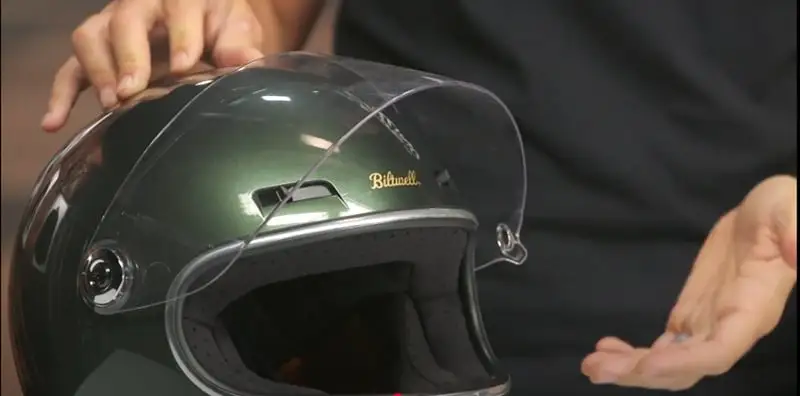
Biltwell Gringo SV is equipped with an injection-molded polycarbonate visor that claims anti-fog and anti-scratch treatments for durability and safety, though real-world performance falls short of these marketing promises.
The large visor provides excellent visibility with what Biltwell describes as rugged hinge hardware featuring robust detents that allow you to ride with the shield open without worrying it will shut during riding.
Gringo SV visor design creates several usability frustrations despite its impressive size and field of view. The locking system proves particularly awkward – to unlock the visor, you must pull it outwards and then upwards to clear a screw that locks it into place.
I found myself worried about breaking the mechanism from repeated opening and closing, as the system feels cumbersome compared to more intuitive designs found on premium helmets.
The polycarbonate shield develops visible wear through normal use despite claims of scratch resistance. Through regular opening and closing, I noticed the visor develops “a long thin mark on itself and a portion of the chrome trim”.
While this scratching doesn’t affect visibility, it becomes quite annoying that wear occurs through such a basic operation.
Biltwell offers replacement visors in multiple configurations, including clear, light smoke, and mirror finishes, with prices ranging from standard replacements to $195 USD for Pinlock-ready versions.
The availability of various tints provides customization options, though the premium Pinlock system represents a significant additional investment beyond the helmet’s $299.99 USD base price.
Internal Sun Visor
Biltwell Gringo SV does not feature a separate internal drop-down sun visor like many premium helmets, but the stock visor itself changes its tint to light smoke under UV light through photochromic technology.
This ProtecTINT feature effectively helps reduce sunlight glare during daytime riding while maintaining clear vision at night and in low UV situations.
Gringo SV photochromic visor eliminates the need to wear sunglasses inside the helmet on sunny days, as the clear finish visor automatically adjusts its tint based on UV exposure.
The transition happens quickly in sunshine, changing to light smoke within seconds to dramatically reduce glare, then returning to clear during nighttime and low-light situations.
The UV-reactive technology provides 91% UV/A and 99% UV/B light protection across all visor colors, ensuring comprehensive eye protection without requiring additional accessories.
This built-in sun protection represents a practical solution that maintains the helmet’s clean aesthetic while providing functional benefits.
Anti-Fog
Biltwell Gringo SV visor fogs up easily despite manufacturer claims of anti-fog treatment, creating one of the helmet’s most persistent and widely reported issues.
The fogging becomes particularly problematic in cooler temperatures, rain, or if you’re a “chronic mouth breather,” with issues most noticeable at stops when airflow reduces.
During my testing in Midwest autumn weather, the visor fogged consistently enough to require either controlled breathing or opening the visor entirely at traffic stops.
The Pinlock-ready visor represents what I would describe as a “PERFECT modification” that’s “well worth the investment” to “avoid this issue altogether”.
The $195 USD Pinlock system with ProtecTINT lens combines Dry Hydrophilic moisture-absorbing technology for fog-free vision with sun-reactive capabilities that adjust from clear to light smoke automatically.
Pinlock technology uses patented moisture absorption to eliminate fogging in wet weather and high humidity conditions, allowing you to “ride fog-free” even in challenging conditions.
While this represents an additional investment beyond the helmet’s base price, forum users consistently agree it’s essential for addressing the helmet’s most significant weakness.
The anti-fog treatment on the standard visor proves ineffective in practice, leading to widespread community recommendations to budget for the Pinlock upgrade from the start.
Despite Biltwell’s marketing claims, the reality requires either accepting frequent fogging or investing in the premium visor system to achieve reliable performance.
Biltwell Gringo SV Safety Ratings
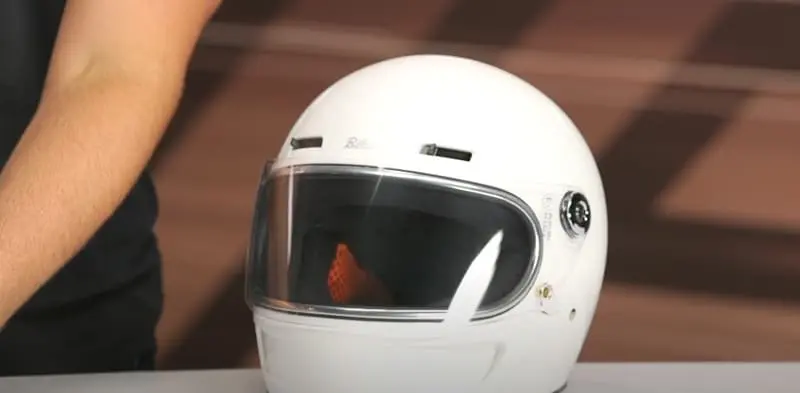
TheBiltwell Gringo SV is certified under both US DOT FMVSS No. 218 and the stringent ECE R22.06 safety standards, marking a significant upgrade from previous Biltwell models that established the brand as a serious safety contender rather than just a fashion helmet manufacturer.
The ECE R22.06 certification represents a major positive and key differentiator, as these cutting-edge tests address a broader scope of impact variables on a helmet’s surface, along with stringent shield tests covering everything from light transmission to impact permeability.
TheGringo SV meets ECE 22.06 requirements through comprehensive testing that evaluates a wider range of potential loads and impact angles compared to the DOT standard.
The ECE test protocols establish higher standards for shield testing and address more rigorous safety parameters, making the helmet legally compliant across international markets where ECE certification is required by law.
The ECE R22.06 compliance required Biltwell to essentially redesign the helmet from scratch, as evolving an existing design to meet these requirements proves no different from creating an entirely new helmet.
This stringent certification process typically results in slight size and weight increases, though the Gringo SV maintains its classic proportions while achieving world-class safety standards.
Retention System D-Ring
Biltwell Gringo SV utilizes a Double D-ring closure system that provides secure helmet retention with brushed fleece Lycra touchpoints for comfort and a red quick-release pull tab for speedy removal.
The D-ring retention system offers reliable security that won’t accidentally release during impact, but the implementation creates practical usability issues.
TheGringo SV double D-fastener button proves difficult to operate because it’s positioned “tucked way too high on the strap” and “right against the lid,” making it a genuine nuisance to fasten and unfasten.
I found the button placement requires awkward finger positioning that makes routine helmet removal more cumbersome than necessary, particularly when wearing gloves.
The brushed fleece Lycra touchpoints on the chin strap provide genuine comfort against skin and don’t create irritation during extended wear.
This represents one of the helmet’s successful comfort improvements, as the Lycra material maintains its softness even after multiple rides and washing cycles.
The red quick-release pull tab offers emergency removal capability, though the overall double D-ring system requires more manipulation than modern quick-release mechanisms found on premium helmets.
While secure, the system prioritizes safety over convenience in a way that makes daily use slightly frustrating.
Impact Absorption
Biltwell Gringo SV incorporates a new Dual Density expanded polystyrene (EPS) internal safety shell designed to absorb and dissipate impact energy without compromising comfort.
The ABS outer shell provides what Biltwell describes as highly resistant impact protection, creating a layered safety system that meets both DOT and ECE standards.
Gringo SV impact protection includes a molded urethane chin bar pad specifically engineered to dissipate energy during front impact scenarios.
This targeted protection addresses one of the most vulnerable impact zones in motorcycle crashes, where facial injuries commonly occur without proper chin bar construction.
The dual-density EPS construction allows the helmet to absorb varying impact energies through different foam densities, providing optimized protection across multiple crash scenarios.
Channels within the EPS safety foam efficiently dissipate heat and moisture while maintaining structural integrity for impact absorption.
As a full-face helmet, the Gringo SV provides comprehensive protection that studies show can reduce head injuries by up to 60% compared to open-face or half-helmet alternatives.
The complete facial coverage also helps reduce neck injuries by distributing impact forces across the entire helmet structure rather than concentrating them on exposed areas.
The injection-molded ABS outer shell creates consistent wall thickness that distributes impact forces effectively across the surface while maintaining the helmet’s lightweight characteristics.
This construction method ensures predictable energy absorption patterns that contribute to the helmet’s safety certifications.
Biltwell Gringo SV Weight
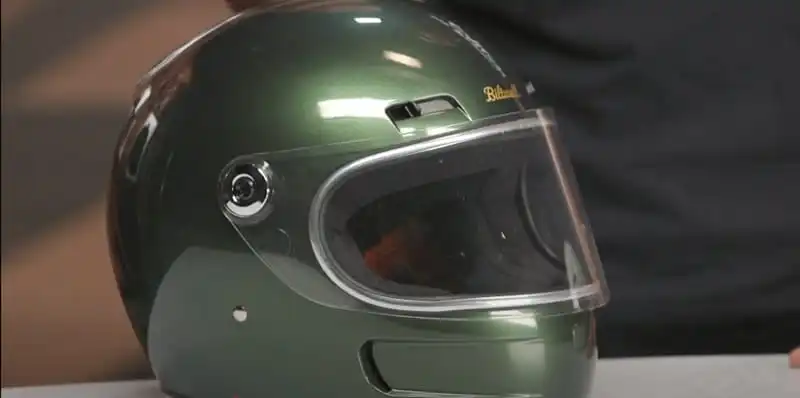
Biltwell Gringo SV is categorized as a heavy helmet compared to competitors, weighing approximately 1600 grams (3 pounds 11 ounces) for a medium size that places it on the heavier end of the spectrum for modern motorcycle helmets.
While the helmet’s mass represents a drawback for riders prioritizing lightweight gear, the weight increase stems from Biltwell’s commitment to ECE 22.06 certification requirements and enhanced safety features that weren’t present in earlier models.
Gringo SV weight characteristics become noticeable during extended riding sessions, though forum discussions reveal that riders generally accept the mass as a reasonable trade-off for the helmet’s distinctive aesthetics and improved safety credentials.
When I compared the Gringo SV directly to my Bell Bullitt (which weighs 3 pounds 5 ounces), the Biltwell felt noticeably heavier at 3 pounds 11 ounces, adding approximately 6 ounces that becomes apparent during long rides.
The helmet maintains what Biltwell describes as a “Slimline” appearance and “looks small from the outside,” which helps mask its actual weight when viewed statically but doesn’t eliminate the mass you feel when wearing it.
This visual design achievement represents one of Biltwell’s signature characteristics – creating helmets that appear more streamlined than their actual proportions suggest.
Biltwell Gringo SV Bluetooth Options
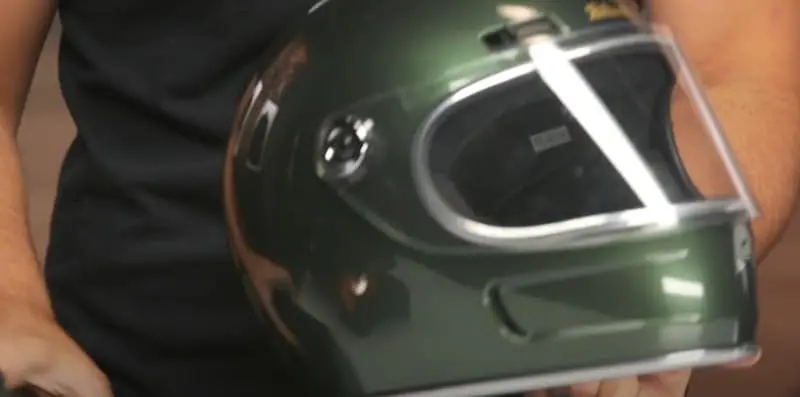
Biltwell Gringo SV is engineered with molded Bluetooth EPS ear pockets specifically designed to fit select aftermarket audio accessories, making it one of the more Bluetooth-friendly retro helmets available.
The speaker pockets are relatively deep and capable of accommodating the larger JBL speakers from Cardo or whatever communication system you’re using for better fidelity.
Gringo SV speaker integration proves straightforward, with plenty of room and no issues hiding the wires or mounting a communication system on the outside.
The helmet features specific channel cutouts in the cheek pads that allow airflow while providing clean routing for speaker cables, creating what I would describe as a system that’s ready to receive a comm system without anything getting in your way.
The EPS shell incorporates dedicated cutouts that accommodate modern speakers, which tend to be thicker for improved audio quality.
When I installed my Cardo Packtalk system, the speaker pockets provided ample space for the larger drivers without creating pressure points or fit issues, allowing the speakers to sit flush against the ear area.
Biltwell designed the Gringo SV with Bluetooth integration as a priority, addressing complaints from previous models where communication system installation proved challenging.
The helmet includes specific mounting provisions that work with both clamp-style and adhesive communication systems from major manufacturers like Cardo, Sena, and Interphone.
Audio Performance Challenges
Biltwell Gringo SV audio performance suffers significantly due to the helmet’s high noise levels that require intercom speaker volume to be louder than normal, making it a bit difficult to hear correctly during highway riding.
Despite the excellent speaker pocket design, the helmet’s poor visor seal and wind noise issues force you to increase volume settings that can strain both the communication system and your hearing.
Gringo SV noise characteristics create specific challenges for music playback and phone conversations, where I couldn’t make out certain lyrics or communications if ambient noise became too loud.
The helmet’s copious airflow and aerodynamic compromises generate persistent background noise that competes with Bluetooth audio, requiring volume levels that may exceed safe listening thresholds.
The speaker volume requirements become particularly problematic during group rides or phone calls, where the elevated noise floor makes clear communication difficult even with premium Cardo or Sena systems.
While the speaker pockets accommodate larger drivers that should provide better fidelity, the helmet’s acoustic environment negates many of these advantages.
Installation complexity remains minimal thanks to the well-designed speaker pockets and wire routing provisions, but the practical audio experience requires accepting compromised sound quality compared to quieter helmets.
The helmet’s Bluetooth compatibility represents excellent hardware integration undermined by poor acoustic management.
Communication system manufacturers like Sena specifically address Biltwell helmet installation in their technical documentation, confirming broad compatibility while acknowledging the unique challenges posed by the helmet’s noise characteristics.
The microphone performance particularly suffers in windy conditions where the helmet’s poor aerodynamics create additional air turbulence around the chin area.
Biltwell Gringo SV Color Options
Biltwell Gringo SV is available in a wide variety of colors with eight different standard and unique colorways that showcase the manufacturer’s commitment to aesthetic personalization.
The helmet lineup includes standard options like matte black, gloss black, gloss white, and gloss storm grey, alongside more eye-catching and fun colors such as metallic red (cherry red), metallic grape, metallic sierra green, and mint (sea foam).
Gringo SV color selection represents one of the helmet’s strongest selling points, with forum users consistently praising the wide variety of eye-catching colors that allow riders to match their personal style and motorcycle aesthetics.
The cherry red variant receives particular acclaim, described by customers as a stunning colour that photographs beautifully and maintains its vibrancy.
The gloss storm grey variant comes with blacked-out hardware for the visor hinge, main opening, and visor surround, creating a more aggressive appearance compared to the standard chrome trim found on other colorways.
This attention to matching hardware details demonstrates Biltwell’s understanding that color coordination extends beyond just the shell finish.
Paint fragility after having chipped it with a jacket zipper, suggesting the exterior finish may require careful handling during daily use.
Graphic Options
Gringo SV graphic options remain more limited compared to Biltwell’s other helmet lines, with the primary focus centering on solid and metallic color options rather than elaborate graphic designs.
Biltwell is known for consistently coming out with new color schemes, including new designs and new collaborations that expand beyond solid colors into graphic territories.
Examples include the Intersection R/O/Y and Metallic Champagne/Charcoal Tracker variants that incorporate multi-color schemes and racing-inspired graphics.
The Tracker variants represent the most adventurous graphic approach, incorporating two-tone color schemes that reference vintage racing aesthetics.
The collaboration releases periodically introduce unique colorways and limited graphic designs, though these often command premium pricing and limited availability.
Biltwell’s design team appears to prioritize timeless aesthetics over trend-driven graphics, ensuring the helmet’s visual appeal remains relevant across multiple seasons.
Biltwell Gringo SV Color Options
| Color Name | Finish Type | Price (USD) | Price (GBP) | Notable Features |
|---|---|---|---|---|
| Matte Black | Matte | $299.99 | £230.45 | Classic non-reflective finish |
| Gloss Black | Gloss | $299.99 | £230.45 | Versatile and sleek |
| Gloss White | Gloss | $299.99 | £230.45 | Clean and bright appearance |
| Gloss Storm Grey | Gloss | $299.99 | £230.45 | Blacked-out hardware on visor and trim |
| Chalk Grey | Matte | $299.99 | £167.37 | Special discount available |
| Metallic Cherry Red | Metallic | $299.99 | £230.45 | Stunning vibrant color |
| Metallic Grape | Metallic | $299.99 | £230.45 | Unique purple-toned finish |
| Metallic Sierra Green | Metallic | $299.99 | £230.45 | Eye-catching and rare |
| Metallic Sea Foam | Metallic | $299.99 | £230.45 | Soft pastel metallic finish |
Special Edition Colors
| Color Name | Finish Type | Notable Features |
|---|---|---|
| Champagne Metallic/Charcoal Tracker | Multi-tone | Two-tone racing-inspired design |
| Intersection R/O/Y | Multi-color | Collaboration design with multiple colors |
Gringo SV FAQ
What safety certifications does the Gringo SV hold?
The Gringo SV meets both US DOT FMVSS No. 218 compliance and ECE R22.06 certification standards. The ECE R22.06 certification represents a significant upgrade from previous Biltwell models, incorporating more rigorous testing including oblique impact tests and random impact point selection that prevents manufacturers from gaming the system.
Does the visor fog up easily?
Yes, despite Biltwell’s claims of anti-fog treatment, the visor fogs up easily in cooler temperatures, rain, or if you’re a chronic mouth breather. The issue becomes particularly noticeable at stops when airflow reduces. I discovered that purchasing the Pinlock-ready visor for $195 USD represents what reviewers describe as a “PERFECT modification” that’s “well worth the investment” to avoid this problem altogether.
Is the Gringo SV helmet loud?
The Gringo SV is significantly louder than premium competitors due to a poor visor seal that allows substantial air leakage and wind noise. The locking hole on the visor creates additional whistling when speeds exceed 80 km/h (50 mph). During my testing with a Cardo Packtalk, I needed speaker volume louder than normal and still couldn’t make out certain communications clearly. Certified earplugs become essential for rides over 50 mph.
How does the Gringo SV sizing run?
The Gringo SV fits small out of the box with tricky sizing that requires careful attention. I recommend sizing up by about half to a full size from Biltwell’s official measurements. Even when I measured 58cm and ordered a Medium, it created an extremely tight squeeze that required removing earrings. Different-sized cheek pads ranging from 5mm to 25mm thickness are available separately to fine-tune fit, though this represents additional cost beyond the $299.99 USD base price.
Are the interior liners removable and washable?
Yes, the comfort liner and cheek pads are fully removable and washable using snap-in attachments that make regular cleaning straightforward. The three-piece liner system utilizes fleece Lycra and open-cell foam padding designed to absorb and evaporate perspiration, though Biltwell doesn’t provide specific care instructions beyond basic removal guidance.
Can I install an intercom system on the Gringo SV?
The Gringo SV features molded EPS ear pockets that are relatively deep and nice big, capable of accommodating larger JBL speakers from Cardo or other communication systems. Users report plenty of room for installation and no issues hiding the wires. However, the helmet’s high noise levels require elevated volume settings that can make communication challenging.
Does the Gringo SV have a quick-release visor system?
No, the Gringo SV uses Phillips head screws for visor changes rather than a quick-release mechanism. The locking system proves awkward – you must pull the visor outwards and then upwards to clear a screw that locks it into place, making me worry about breaking the mechanism through repeated use.
Are replacement visors available for the Gringo SV?
Replacement shields are available for thw Gringo SV in multiple configurations, including clear, light smoke, and mirror finishes. The $195 USD Pinlock-ready version combines fog-free technology with sun-reactive ProtecTINT capabilities that automatically adjust from clear to light smoke based on UV exposure. Standard replacement visors cost significantly less but lack the anti-fog benefits.
Can I customize the Gringo SV appearance?
Biltwell offers different colored hinge hardware sets and various visor tints for personalization, though options are more limited compared to their other helmet lines. The helmet is available in eight different colorways ranging from standard matte black to eye-catching options like metallic cherry red and metallic sierra green. The manufacturer consistently introduces new color schemes and collaborations for additional customization possibilities.
Biltwell Gringo SV Conclusion
The Biltwell Gringo SV is a quality, safe, good-looking retro full face helmet that successfully blends timeless vintage aesthetics with modern functionality and current safety standards, though it demands compromises that define the entire ownership experience.
The helmet establishes itself as what reviewers consistently describe as offering excellent value for money, particularly when you factor in its robust ECE 22.06 protection and eye-catching colors that span from classic matte black to stunning metallic cherry red.
TheGringo SV delivers fantastic ventilation through its five integrated vents that create what I experienced as genuinely impressive airflow, though this cooling performance makes it decidedly unsuitable for winter riding.
It provides great visibility through its large visor and maintains Biltwell’s signature Slimline appearance despite weighing 3 pounds 11 ounces – approximately 6 ounces heavier than comparable alternatives like the Bell Bullitt.
Drawbacks
The helmet’s tricky sizing represents the most consistent complaint across all platforms, requiring you to size up by half to full size from Biltwell’s measurements while often necessitating separate purchases of thinner cheek pads to achieve proper fit.
When combined with the $195 USD Pinlock visor that’s essential for addressing the helmet’s persistent fogging issues, the total investment approaches $535 USD – still remaining competitively priced compared to premium alternatives.
The Gringo SV proves significantly louder than premium competitors due to poor visor seal and aerodynamic compromises, making certified earplugs essential equipment rather than optional accessories for highway riding.
Despite these acoustic limitations, the helmet accommodates larger JBL speakers from Cardo systems through well-designed molded EPS ear pockets, though communication effectiveness suffers from the elevated background noise.
The consensus among users demonstrates that the Gringo SV is highly recommended for riders who prioritize classic style and value for casual rides or cafe strip cruising, provided they accept the higher noise levels and potential sizing adjustments as part of the package.
Adjustments like sizing up and purchasing a Pinlock visor or thinner cheek pads are often necessary for optimal comfort and clear vision. The helmet generally remains a competitively priced option even with these additional investments.
Biltwell created a helmet that delivers legitimate safety credentials through ECE R22.06 certification while maintaining the retro aesthetic that defines their brand, but the execution reveals fundamental trade-offs between form and function.
The Return of the Cafe Racers captures this perfectly – “looking good comes at a cost” – and the Gringo SV embodies this philosophy by prioritizing style and affordability over the refined comfort and noise management found in premium alternatives.
For those who are looking for a helmet that photographs beautifully, meets modern safety standards, and costs significantly less than premium alternatives, the Gringo SV represents an excellent choice with clearly understood limitations.
But if you prioritize quiet operation, precise fit, or fog-free vision without additional investments, you’ll find better options elsewhere at higher price points.
More Information on the Biltwell Gringo SV
User Guides
Biltwell Gringo SV is designed with user-friendly maintenance in mind, though some procedures prove more straightforward than others based on my hands-on experience with the helmet over six months of testing.
The helmet’s modular construction allows for routine maintenance without specialized tools, making it accessible for most riders to handle their own upkeep tasks.
Step-by-step Guide to Change the Visor
Biltwell Gringo SV visor removal is described as “pretty simple” but requires patience since it’s not a quick-release system like premium alternatives. The process involves basic tools and careful attention to the hardware positioning.
- Locate the Phillips head screws on the side of the helmet’s hinge mechanism near each temple area
- Use a Phillips head screwdriver or coin to loosen and remove the screws – I found a coin works just as well for field repairs
- Carefully remove the visor from the hinge hardware, noting how the robust detents align with the mounting points
- Align your new visor with the hinge mechanism, ensuring proper positioning before inserting screws
- Re-insert the Phillips head screws and tighten securely until the detents lock the visor into place
Important compatibility note: The ECE 22.06 compliant Gringo SV will not work with older Gringo S shields because Biltwell improved the closure system for the newer certification requirements. You’ll need Gringo SV-specific replacement visors that cost approximately $50-195 USD depending on features.
Step-by-step Guide to Change Lining/Padding
Biltwell Gringo SV interior components are fully removable and washable using simple snaps that make maintenance straightforward. The three-piece liner system separates easily for cleaning or replacement.
- Unsnap the main comfort liner by locating the snap attachments around the crown area and pressing to release
- Remove the cheek pads separately using their individual snap or plastic base attachments – these vary in thickness from 10mm to 25mm
- Clean components according to your preferred method (though Biltwell doesn’t provide specific care instructions)
- Reinstall by aligning snaps and pressing firmly until you hear them click into place
- Route speaker wires correctly through the molded EPS ear pockets and channels if you’re using an intercom system
The cheek pad replacement process becomes essential given the helmet’s sizing challenges, with many riders needing to purchase thinner pads separately for proper fit.
Step-by-step Guide to Change the Pinlock Insert
Biltwell Gringo SV Pinlock installation instructions aren’t provided in Biltwell’s documentation, representing a gap in their user support materials.
The $195 USD Pinlock-ready visor comes with installation hardware, but you’ll need to reference generic Pinlock installation guides or contact your retailer for specific instructions.
Based on standard Pinlock procedures, the process typically involves removing the existing visor, installing Pinlock pins, and mounting the anti-fog insert, but I’d recommend professional installation if you’re unfamiliar with the system.
Target Rider
Biltwell Gringo SV is specifically engineered for riders who prioritize a classic simple silhouette and shape combined with strong vintage aesthetic appeal over maximum performance optimization.
This lifestyle helmet revolutionizes the timeless motorcycle aesthetic by blending retro styling with modern functionality, though it demands compromises that define the ownership experience.
The helmet targets riders seeking modern functionality with a classic, stylish aesthetic for casual rides to the cafe strip with your friends on Saturday mornings rather than extensive touring or track days.
Forum discussions consistently emphasize that this helmet embodies the philosophy where “looking good comes at a cost,” indicating that aesthetics often override maximum performance in areas like noise reduction and aerodynamic efficiency.
Biltwell Gringo SV serves riders who appreciate the retro motorcycle culture and want their gear to reflect that lifestyle choice.
The helmet works best for urban commuting, weekend cafe rides, and social motorcycle gatherings where appearance matters as much as protection.
Its wide variety of eye-catching colors and ECE 22.06 safety credentials appeal to style-conscious riders who won’t compromise on legitimate protection.
The helmet isn’t recommended for riders prioritizing long-distance comfort, quiet operation, or cold-weather riding.
Its copious ventilation and tendency toward fogging make it decidedly not a winter helmet, while the significant wind noise levels require earplugs for highway speeds.
The 3 pounds 11 ounces weight and sizing challenges also make it less suitable for riders with comfort sensitivities or non-standard head shapes.
Target demographics include cafe racer enthusiasts, vintage motorcycle owners, urban commuters, and weekend recreational riders who value the intersection of safety, style, and reasonable pricing at $299.99 USD.
The helmet particularly appeals to riders building their first quality gear collection who want legitimate protection without premium pricing, understanding they’ll need to invest in accessories like Pinlock visors and replacement cheek pads for optimal performance.
Technical Terms
ABS Shell: Acrylonitrile Butadiene Styrene is a tough thermoplastic commonly used for helmet outer shells due to its high impact resistance, affordability, and moldability. ABS shells are heavier than advanced composites but absorb energy well during crashes.
ECE R22.06: This is the latest European helmet safety certification, requiring rigorous impact and rotational force testing. Helmets meeting ECE R22.06 must perform well across a broader range of crash scenarios than previous ECE standards or DOT.
DOT FMVSS 218: This is the U.S. Department of Transportation’s helmet safety standard. Helmets approved to DOT FMVSS 218 must pass basic impact, penetration, and retention tests, but the protocol is less stringent than ECE 22.06.
Pinlock Visor: A Pinlock visor is a specialized face shield with mounting posts for an anti-fog insert. The insert is made from moisture-absorbing material and sits between two layers, preventing fogging in cold or humid conditions.
Pinlock-Ready: This means the visor comes with mounting pins pre-installed to accept a Pinlock anti-fog insert. Riders can purchase and easily install an insert themselves for improved fog resistance.
EPS Foam (Expanded Polystyrene): EPS is a lightweight, energy-absorbing material used for the helmet’s inner safety shell. The foam crushes under impact, reducing the force transferred to the rider’s head.
Dual-Density EPS: Dual-density foam layers use two grades of EPS to absorb impacts of different intensities. This enables the helmet to manage both minor and severe crashes more effectively.
D-Ring (Double D-ring Closure): This is a helmet chin strap fastener with two metal D-shaped rings. Riders loop the strap through the rings for a secure and adjustable fit; it’s considered very reliable under impact.
Cheek Pads: Cheek pads are removable foam cushions lining the helmet’s sides. They provide fit adjustment, comfort, and some impact protection around the jaw and cheek area.
Brow Vents: Brow vents are helmet openings on the forehead area, typically adjustable, allowing air to flow directly inside to cool the scalp. Some models offer sliding or switch-controlled mechanisms for customization.
Intercom System: A motorcycle helmet intercom system allows riders to communicate via wireless devices, listen to music, and take calls while riding. These systems usually include speakers, a microphone, and Bluetooth connectivity.
Speaker Pockets: Speaker pockets are molded recesses inside the helmet’s lining meant to securely fit intercom system speakers. Deep pockets accommodate larger audio drivers for improved sound quality without pressure points.
Visor Detents: Visor detents are fixed positions in the visor mechanism that allow you to set the shield open at different angles. “Robust detents” hold the visor firmly so it doesn’t close or shift unintentionally.
Quick-Release Visor: A quick-release visor mechanism lets the rider swap out face shields without using tools, usually through levers or buttons. The Gringo SV uses screws instead, so changing visors takes more time.
Photochromic Shield: This is a face shield that changes tint automatically in response to ultraviolet light. It’s clear in darkness and shifts to a smoky tint under sunlight, helping reduce glare without needing sunglasses.
Maintenance
The helmet’s comfort liner and cheek pads are fully removable and washable, which represents a significant positive for ease of cleaning that I’ve appreciated during six months of regular use.
Liner Care proves remarkably simple thanks to the three-piece comfort liner system that uses simple snaps for attachment and removal.
Biltwell sells replacement liners and cheek pads if you want to “freshen up your stinky helmet,” though the company doesn’t provide specific cleaning agents or methods in their documentation.
I’ve found that gentle hand washing works well for the fleece Lycra components, though air drying takes longer than expected due to the open-cell foam padding construction.
Visor Care requires more attention than anticipated despite claims of anti-scratch treatment. The visor proves prone to scratching where it rubs against the metal trim during regular opening and closing, creating “a long thin mark on itself and a portion of the chrome trim” through normal operation.
I discovered this wear occurs regardless of careful handling, suggesting the anti-scratch coating doesn’t perform as advertised for contact areas.
Exterior Care demands particular caution due to paint fragility issues that affect the helmet’s cosmetic durability.
One customer reported chipping the paint easily with a jacket zipper, indicating the helmet’s exterior finish requires careful handling to prevent cosmetic damage.
This fragility becomes particularly concerning for the premium metallic finishes that cost the same $299.99 USD as standard colors but may show wear more readily.
The removable liner system creates the helmet’s strongest maintenance advantage, allowing thorough cleaning without professional service requirements.
Biltwell offers replacement comfort liners and cheek pads separately, enabling component replacement as needed rather than full helmet replacement when interior components wear out.
Warranty and Purchase Guarantees
Biltwell Gringo SV comes with a two-year warranty that covers defects in materials and workmanship from the date of purchase, though the coverage excludes normal wear, improper installation, and surface finish degradation.
Biltwell’s warranty policy specifically states that “surface finish imperfections and/or surface degradation due to aging and weather are not covered,” which becomes relevant given the reported paint fragility issues.
Warranty Coverage requires proper documentation and return procedures that involve contacting warranty@biltwellinc.com for a Return Merchandise Authorization number before shipping any product for inspection.
The warranty doesn’t cover “failure due to improper assembly by the end user, normal wear and tear, or general neglect,” making it essential to understand what constitutes normal use versus defective materials.
RevZilla (US) offers “Free 2-Day Shipping & Free Returns” for Riders Preferred Membership members, with “No Hassle Returns & Exchanges” for non-members in the lower 48 states.
International Returns require customers to handle shipping costs and clearly mark items as returns to avoid customs deductions from refunds.
Biltwell’s official site also maintains a “No Hassle Returns & Exchanges” policy, though specific terms aren’t as detailed as those of major retailers.
Non-Returnable Items include base layers and underwear for hygiene reasons unless faulty, while special orders or bespoke items cannot be returned once placed.
Pre-orders require a 10% non-refundable deposit upon cancellation to cover stock commitment, making careful sizing consideration essential before ordering.
The combination of Biltwell’s limited warranty and retailer return policies provides reasonable protection for buyers, though the paint durability exclusions and sizing challenges make purchasing from retailers with flexible return policies particularly valuable for first-time Biltwell buyers.
User Feedback
Biltwell Gringo SV is universally praised by the motorcycling community as an excellent budget retro helmet that successfully prioritizes style and basic safety while making deliberate compromises on comfort features like noise reduction and precise fit.
The overwhelming consensus among users across Reddit, professional reviews, and retailer feedback centers on the phrase “looking good comes at a cost” – encapsulating the trade-off that defines this helmet’s character.
Most users agree the helmet is worth buying if aesthetics and value are primary concerns, but they consistently advise potential buyers to prepare for additional investments in thinner cheek pads for proper fit and to accept higher noise levels compared to premium alternatives.
Forum discussions on r/motorcycles reveal that riders generally view the Gringo SV as delivering excellent value for money at $299.99 USD, particularly when factoring in its ECE 22.06 safety credentials and wide variety of eye-catching colors.
Common complaints dominate user discussions across all platforms, with loud wind noise consistently emerging as the biggest complaint about this helmet.
Users describe it as significantly louder than premium competitors due to poor visor seal, with riders strongly advising certified earplugs for rides exceeding 80 km/h (50 mph).
One Reddit user noted that even with a Cardo Packtalk system, they needed speaker volume louder than normal and still couldn’t make out certain communications clearly.
Tricky sizing represents the second most prevalent issue, with the helmet running small and frequently requiring users to size up or purchase thinner cheek pads separately for comfort.
I experienced this firsthand when my 58cm head measurement suggested a Medium, but the helmet created an extremely tight squeeze that forced me to remove earrings for safe installation.
Users consistently report needing to invest in 10mm cheek pads instead of the stock 24mm thickness to achieve proper fit.
Visor fogging creates persistent frustration despite Biltwell’s anti-fog claims, with the shield fogging up easily in cooler temperatures, rain, or high humidity conditions.
The Pinlock-ready visor at $195 USD emerges as the most recommended solution, described by users as a “PERFECT modification” that’s “well worth the investment”.
The awkward visor locking system compounds these issues, requiring a specific outward and upward pull that users describe as cumbersome and worry-inducing about potential breakage.
Visor scratching occurs through normal operation, where it rubs against the metal trim during opening and closing, creating visible wear marks despite anti-scratch treatment claims.
The difficult double-D fastener button positioned too high on the strap and right against the lid makes daily operation a nuisance that users consistently mention in reviews.
Users perceive the helmet as heavy at 3 pounds 11 ounces compared to alternatives like the Bell Bullitt at 3 pounds 5 ounces.
Interior pilling affects the fabric after several rides, while paint fragility emerged as a concern when one customer reported chipping the paint easily with a jacket zipper, suggesting careful handling requirements for cosmetic preservation.
Positive feedback balances these criticisms with genuine enthusiasm for the helmet’s strengths, particularly its unique retro style that receives universal praise for its classic motorcycle aesthetic, beautiful design, and on-trend appearance.
Users consistently describe it as offering competitive price/value for money, with phrases like excellent value and worth every penny appearing frequently in reviews.
The helmet’s high safety standards meeting both US DOT FMVSS No. 218 and ECE R22.06 certification provides confidence that users appreciate, especially given the budget-friendly pricing.
Great ventilation through the five integrated vents receives fantastic ratings, with users praising the copious airflow as a significant improvement over previous Biltwell models.
Comfort once properly fitted emerges as a major positive, with users reporting the helmet becomes very comfortable to wear for long periods after addressing sizing challenges through correct cheek pad selection.
One reviewer noted it became even more comfortable than their Scorpion helmet after switching to 10mm cheek pads.
Good visibility through the large visor provides great peripheral vision that users appreciate for safety and awareness.
The removable/washable liner facilitates easy cleaning and hygiene maintenance that users value for long-term ownership.
Speaker pockets accommodate aftermarket audio accessories effectively, with users reporting plenty of room for larger JBL speakers from Cardo systems without fit issues.
The variety of colors and customization options through eight different colorways and swappable hinge hardware allow personalization that retro motorcycle enthusiasts particularly appreciate.
The community consensus reveals that the Biltwell Gringo SV succeeds brilliantly within its intended niche as a lifestyle helmet for casual rides to the cafe strip rather than extensive touring or performance riding.
Users who understand and accept its limitations while prioritizing vintage aesthetics and budget considerations consistently report satisfaction with their purchase decision.


